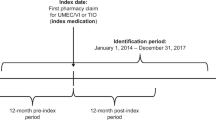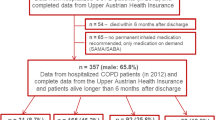Abstract
Background
Adherence to inhaled medication regimens affects chronic obstructive pulmonary disease (COPD) prognosis and quality of life, and reduces the use of healthcare services, resulting in cost savings.
Objectives
To examine the effects of adherence to inhaled medication regimens on healthcare utilization and costs in high-grade COPD patients.
Methods
We performed an observational retrospective cohort study using a longitudinal data set from the Korean Health Insurance Review and Assessment Service (2008–2013) containing healthcare services’ information for 50 million beneficiaries. The study population was high-grade COPD patients. “Adherent” was defined as a patient attaining a medication possession ratio (MPR) ≥ 80%. We estimated the effects of adherence on the use of intensive care units (ICUs) and emergency rooms (ERs) using a multivariate logistic regression, and estimated the effects on costs (all-cause and COPD-related) using a generalized linear model, with adjustment for patient sociodemographic characteristics, health status, and comorbidities.
Results
Of 9086 high-grade COPD patients, adherence declined from 34.7 to 22.3% over 4 years. Adherence was inversely associated with use of ICUs and costs, and this association got stronger as the adherence period lengthened. Over the 4-year period, the adherent group had a lower likelihood of using ICUs [odds ratio (OR) = 0.74, 95% confidence interval (CI) 0.60–0.91] than the non-adherent group. Similarly, the adherent group had a 10.4% lower all-cause cost (p < 0.001) and an 11.7% lower COPD-related cost (p < 0.0001) versus the non-adherent group.
Conclusions
Adherence reduces healthcare utilization and costs, so adherence is not only clinically effective but also economically efficient. However, less than one-quarter of this population remained adherent over the 4-year period, suggesting that strategies are needed to improve adherence.

Similar content being viewed by others
References
Mathers CD, Loncar D. Projections of global mortality and burden of disease from 2002 to 2030. PLoS Med. 2006;3(11):e442.
Oh IH, Yoon SJ, Kim EJ. The burden of disease in Korea. Healthcare Policy. 2011;54(6):646–52.
Yoon HK, Park YB, Rhee CK, Lee JH, Oh YM; Committee of the Korean COPD Guideline 2014. Summary of the Chronic Obstructive Pulmonary Disease Clinical Practice Guideline Revised in 2014 by the Korean Academy of Tuberculosis and Respiratory Disease. Tuberc Respir Dis (Seoul). 2017;80(3):230–40.
Jensen HH, et al. Potential misclassification of causes of death from COPD. Eur Respir J. 2006;28(4):781–5.
Jensen MB, et al. Chronic obstructive pulmonary disease involves substantial health-care service and social benefit costs. Dan Med J. 2013;60(1):A4557.
Kim J, et al. The health care burden of high grade chronic obstructive pulmonary disease in Korea: analysis of the Korean Health Insurance Review and Assessment Service data. Int J Chron Obstruct Pulmon Dis. 2013;8:561–8.
Restrepo R, et al. Medication adherence issues in patients treated for COPD. Int J Chron Obstruct Pulmon Dis. 2008;3:371–84.
Vestbo J, et al. Adherence to inhaled therapy, mortality and hospital admission in COPD. Thorax. 2009;64(11):939–43.
Antoniu S. Adherence to inhaled therapy in COPD: effects on survival and exacerbations. Expert Rev Pharmacoecon Outcomes Res. 2010;10:115–7.
Asche C, et al. Adherence to current guidelines for chronic obstructive pulmonary disease (COPD) among patients treated with combination of long-acting bronchodilators or inhaled corticosteroids. Int J Chron Obstruct Pulmon Dis. 2012;7:201–9.
Toy EL, et al. Treatment of COPD: relationships between daily dosing frequency, adherence, resource use, and costs. Respir Med. 2011;105(3):435–41.
Simoni-Wastila L, et al. Association of chronic obstructive pulmonary disease maintenance medication adherence with all-cause hospitalization and spending in a medicare population. Am J Geriatr Pharmacother. 2012;10(3):201–10.
Ismaila A, et al. Impact of adherence to treatment with tiotropium and fluticasone propionate/salmeterol in chronic obstructive pulmonary diseases patients. Curr Med Res Opin. 2014;30(7):1427–36.
Butler RJ, et al. Effects of nonadherence with prescription drugs among older adults. Am J Manag Care. 2011;17(2):153–60.
Vrijens B, et al. What we mean when we talk about adherence in respiratory medicine. J Allergy Clin Immunol Pract. 2016;4(5):802–12.
Halpern R, et al. Outcomes associated with initiation of tiotropium or fluticasone/salmeterol in patients with chronic obstructive pulmonary disease. Patient Prefer Adherence. 2011;5:375–88.
van Boven JF, et al. Clinical and economic impact of non-adherence in COPD: a systematic review. Respir Med. 2014;108(1):103–13.
Avorn J, et al. Persistence of use of lipid-lowering medications: a cross-national study. J Am Med Assoc. 1998;279(18):1458–62.
Benner JS, et al. Long-term persistence in use of statin therapy in elderly patients. J Am Med Assoc. 2002;288(4):455–61.
Dor A, Encinosa W. How does cost sharing affect drug purchases? Insurance regimes in the private market for prescription drugs. Cambridge: National Bureau of Economic Research; 2004.
Takemura M, et al. Relationships between repeated instruction on inhalation therapy, medication adherence, and health status in chronic obstructive pulmonary disease. Int J Chron Obstruct Pulmon Dis. 2011;6:97–104.
van Boven JF, et al. Enhancing respiratory medication adherence: the role of health care professionals and cost-effectiveness considerations. J Allergy Clin Immunol Pract. 2016;4(5):835–46.
Bourbeau J, Bartlett SJ. Patient adherence in COPD. Thorax. 2008;63(9):831–8.
Delea TE, et al. Effects of fluticasone propionate/salmeterol combination on asthma-related health care resource utilization and costs and adherence in children and adults with asthma. Clin Ther. 2008;30(3):560–71.
Yu AP, et al. Therapy persistence and adherence in patients with chronic obstructive pulmonary disease: multiple versus single long-acting maintenance inhalers. J Med Econ. 2011;14(4):486–96.
van Grunsven PM, et al. Compliance during long-term treatment with fluticasone propionate in subjects with early signs of asthma or chronic obstructive pulmonary disease (COPD): results of the Detection, Intervention, and Monitoring Program of COPD and Asthma (DIMCA) Study. J Asthma. 2000;37(3):225–34.
Rand CS, et al. Long-term metered-dose inhaler adherence in a clinical trial. The Lung Health Study Research Group. Am J Respir Crit Care Med. 1995;152(2):580–8.
Kesten S, et al. Compliance with tiotropium, a once daily dry powder inhaled bronchodilator, in 1 year COPD trials. Chest. 2000;118(4):191S–191S.
Bender BG, Pedan A, Varasteh LT. Adherence and persistence with fluticasone propionate/salmeterol combination therapy. J Allergy Clin Immunol. 2006;118(4):899–904.
Breekveldt-Postma NS, et al. Persistence with inhaled corticosteroid therapy in daily practice. Respir Med. 2004;98(8):752–9.
Krigsman K, Nilsson JLG, Ring L. Adherence to multiple drug therapies: refill adherence to concomitant use of diabetes and asthma/COPD medication. Pharmacoepidemiol Drug Saf. 2007;16(10):1120–8.
Landsberger HA. Hawthorne Revisited: Management and the Worker, Its Critics, and Developments in Human Relations in Industry. Ithaca, NY: Cornell University; 1958.
van Boven JFM, Lavorini F, Dekhuijzen PNR, Blasi F, Price DB, Viegi G. Urging Europe to put non-adherence to inhaled respiratory medication higher on the policy agenda: a report from the First European Congress on Adherence to Therapy. Eur Respir J. 2017;49(5):1700076.
Sulaiman I, et al. Objective assessment of adherence to inhalers by patients with chronic obstructive pulmonary disease. Am J Respir Crit Care Med. 2017;195(10):1333–43.
Taylor TE, Zigel Y, De Looze C, Sulaiman I, Costello RW, Reilly RB. Advances in Audio-Based Systems to Monitor Patient Adherence and Inhaler Drug Delivery. Chest. 2017. https://doi.org/10.1016/j.chest.2017.08.1162.
Acknowledgements
This study was conducted as a part of the project “Trends in medication utilization and adherence to medication among patients with chronic conditions: the case of COPD” by HIRA.
Author information
Authors and Affiliations
Contributions
J-AK contributed to the study concept and design, acquisition, analysis and interpretation of data for the study, drafted and revised the manuscript critically for important intellectual content, and provided statistical expertise. MKL contributed to the interpretation of the data for the study and revised the manuscript critically for important intellectual content. KK contributed to the interpretation of data for the study and revised the manuscript critically for important intellectual content. J-HP contributed to the data analysis for the study and revised the manuscript critically for important intellectual content. CKR contributed to the study concept and design, and interpretation of the data for the study and revised the manuscript critically for important intellectual content. All authors approved the final approval of the version to be published and agreed to be accountable for all aspects of the work in ensuring that questions related to the accuracy or integrity of any part of the work are appropriately investigated and resolved.
Corresponding author
Ethics declarations
Ethics Approval and Consent to Participate
Ethics Committee of Seoul St. Mary’s Hospital approved the present study. The requirement for informed consent from the patients studied was waived by the ethical review board by Seoul St. Mary’s Hospital, the Catholic University of Korea.
Conflict of Interest
CK Rhee received consulting/lecture fees from MSD, AstraZeneca, Novartis, GSK, Takeda, Mundipharma, Sandoz, Boehringer-Ingelheim, and Teva-Handok. Other authors have no competing interests to disclose.
Funding
No funding was provided for this study.
Rights and permissions
About this article
Cite this article
Kim, JA., Lim, M.K., Kim, K. et al. Adherence to Inhaled Medications and its Effect on Healthcare Utilization and Costs Among High-Grade Chronic Obstructive Pulmonary Disease Patients. Clin Drug Investig 38, 333–340 (2018). https://doi.org/10.1007/s40261-017-0612-2
Published:
Issue Date:
DOI: https://doi.org/10.1007/s40261-017-0612-2




